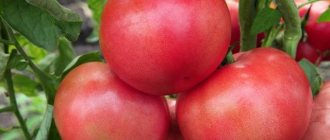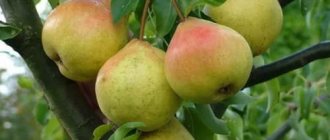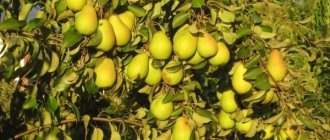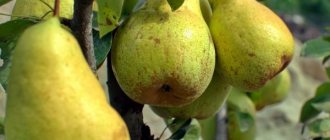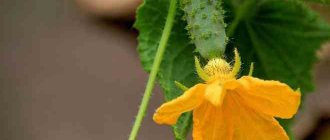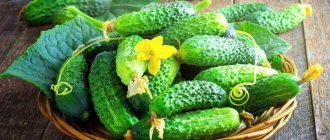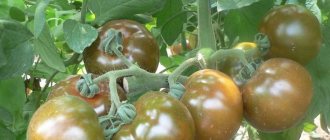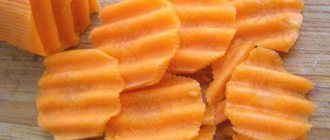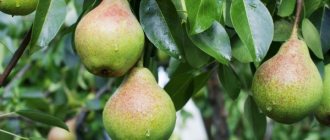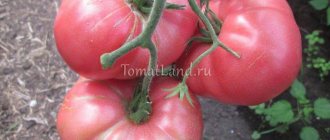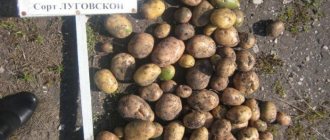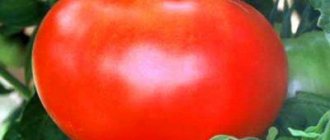Description of pear Elena
Winter pear Elena, with ripening dates at the end of September or beginning of October, is zoned for the southern and central regions of Russia. Despite good winter hardiness, it is not suitable for cultivation in Siberia or the Urals due to the early onset of cold weather, which can prevent fruit ripening. There are positive experiences and reviews about growing Elena pears in the northwestern regions.
Gardeners love the Elena pear for its compact size. The tree rarely grows above 3 meters and, when properly pruned, has a narrow pyramidal crown. This allows you to grow pears in small summer cottages. In addition, it makes tree care and harvesting much easier.
The description of the Elena pear variety notes that it is not prone to excessive formation of shoots and root shoots. The bark on the trunk and skeletal branches is gray-brown, slightly rough to the touch. The shoots are quite sparse, of medium thickness. Young branches have a bright cherry hue, and over time they become brownish-brown. The bark on the branches is smooth and glossy, without edges.
The shoots of the Elena pear are well-leaved. The leaves are large compared to other varieties. They have the shape of an elongated ellipse with finely jagged edges. The leaf plates are painted dark green and have a beautiful glossy shine.
Interesting fact!
Often among gardeners' reviews of the Elena pear variety there are descriptions of leaves that seem to be folded in half along the central axis. In the absence of other signs, this fact does not indicate any disease of the fruit tree.
According to the photos submitted by the owners of the garden plots, the Elena pear blooms profusely, forming snow-white flowers of medium size.
The fruits of the Elena pear are large, regular cone-shaped with a wide base. Their average weight is 200 grams. However, in particularly fruitful years, pears vary somewhat in shape and size. Their skin is quite soft and delicate. At the moment of technical maturity, it has a greenish-yellow tint and is slightly oily to the touch. As it ripens, it becomes a rich yellow color with a slight pink blush and pronounced subcutaneous dots.
The Elena variety pear deserves the highest marks for its taste. According to various sources, its tasting score is 4.6-4.8 points. The pear pulp is creamy, juicy, soft. There is no feeling of looseness or graininess. The taste is sweet, with peculiar sour notes. The fruits have a delicate, spicy aroma.
Description of the variety
This tree belongs to the early ripening varieties. The material for breeding the Russian beauty was the Belgian pear variety Ferdinant and Daughter of Blankova. From its ancestors, this variety took on tall growth, strong immunity, excellent resistance to frost, attractive and tasty fruits. Russian beauty is grown in the Black Earth Region and the central region of Russia. This pear is not grown for commercial purposes or in large quantities.
Tree
The height of the Russian Beauty pear tree can reach 5 meters. The crown is conical, the shoots directed upward have a smooth bend. The bark is brown, and the young shoots have a red tint. The branches are of medium thickness and glossy. The branches are slightly geniculate and lack pubescence. Small buds are formed, from which leaves appear. But those buds that bear fruit are quite large, they have a conical shape and a dark brown tint.
Fruit
The fruits of the Russian beauty have the following characteristics:
- pears are quite large, the average weight reaches 200 grams;
- the fruit is elongated and tuberous;
- productivity is characterized by its heterogeneity;
- medium-thick pear peel, which improves marketability;
- the peel is covered with a coating of natural wax;
- by the time of removal, the fruit has a green tint, rare fruits have a tan;
- when ripe, the fruit is colored golden-green, the side is colored red;
- the stalk is long and curved, holds the fruit well, pears fall off extremely rarely;
- pulp of medium density, semi-oily texture;
- pear has a delicate aroma;
- ripening occurs in late summer;
- the fruits are stored for one and a half months, further storage is impossible;
- the marketability and taste of pears remains high;
- The yield allows you to eat pears fresh and make compotes and jams.
Full characteristics of the pear variety Elena
The Elena pear variety was created for cultivation in difficult climatic conditions. It tolerates changes in temperature and humidity well. It is especially valued for its late onset of flowering. Inflorescences that bloom at the end of May are rarely threatened by return frosts.
Frost resistance of the Elena pear is average. However, with proper care, it winters well in the middle zone, where in winters with little snow there are frosts of up to 25-30 degrees.
The variety cannot be called drought-resistant, but moisture deficiency for 10-20 days will not have consequences, even during the period of fruit ripening. The root system reacts more negatively to waterlogging.
Pollinators for pear Elena
Many people are interested in the question of whether the Elena pear is self-fertile or not. It is most likely caused by the late start of fruiting, no earlier than 5-6 years after planting. The tree produces both male and female flowers. This means that the variety can be classified as self-fertile and self-pollinating.
However, experienced gardeners prefer to plant pollinator trees nearby, believing that in this way they stimulate the fruit tree to increase productivity and improve taste. Late-ripening varieties of apple and pear trees are chosen as neighbors. The Kudesnitsa and Yanvarskaya pears and the Dubrovka and Zolotaya apple trees are celebrated.
Productivity of pear variety Elena
The variety belongs to early winter. In the middle zone, ripening dates occur at the end of September. They often cover the first ten days of December. It’s not for nothing that the pear variety is often called beautiful Elena. At this time, the trees look very elegant. Their branches are strewn with yellow-pink fruits. The yield of the variety is 40-50 kg per pear. It largely depends on the lighting. Elena loves plenty of sunshine. Large fruits also require a large amount of nutrients to ripen, so it is worth taking care of fertilizing in a timely manner. For young plants just entering the fruiting phase, timely watering is also important.
Elena pear has a long shelf life if the fruits are collected at the stage of technical maturity. In dark and cool places, such fruits can be stored for up to 4 months. These are the fruits that need to be transported.
As pears ripen, the skin becomes thinner and the fruits become softer. They are best consumed fresh or used for processing. If they are planned to be transported, it will be only over short distances.
Pear Elena is distinguished by its versatility in use. It is good fresh. For the winter, jam or jams are made from its fruits, juice is prepared, and compotes are prepared. The only thing you should not do with this variety is drying or drying its fruits. This is prevented by the large size and juiciness of the pears.
Summer Duchess pear: characteristics and description of the variety
Photo of summer Duchess pear flowers
Important! A characteristic feature of the Duchess pear is the high resistance of the flowers to returning spring frosts - the buds do not freeze even when the temperature drops greatly. Therefore, the yield of this variety is always consistently high.
PLUM VARIETIES!Plum Morning Plum EtudePlum Stanley (Stanley)
Photo of summer Duchess pear pulp
100 g of fruit contains:
- dry matter – up to 13.8%;
- sugars – 8.3%;
- titratable acids – 0.42%;
- ascorbic acid – 5.4 mg;
- P-active catechins – up to 42.6 mg.
ripe fruits do not tolerate transportation well and are not stored for a long time - they need to be processed immediately after picking. at home, the harvested crop can be stored for up to 2 weeks, and in the refrigerator for up to 45 days.
APRICOT! Apricot Royal Apricot Northern Triumph
Interesting!
Many housewives say that this Duchess pear is so sweet that when making jam you have to put lemon in it, or reduce the added sugar to a minimum, otherwise the jam will become candied.
This tree has low resistance to frost and periods of drought (especially young pears).
Planting and care
For the Elena pear, it is important to choose the right place for cultivation and comply with all planting conditions. In this case, gardeners will make it much easier for themselves to care for their fruit crops, and will provide a considerable foundation for a stable annual harvest.
Deadlines
In the southern regions, it is preferable to plant in early spring. In the middle zone, the optimal planting dates are September and October. Before the onset of cold weather, the seedlings will have time to take root.
Preparatory activities
Descriptions of planting and photos of places for growing Elena pears from experienced gardeners indicate that it is important to correctly decide where to plant it. For this variety, you should choose sunny places on the south or east side of buildings or fences, which will serve as a natural shelter for the plants from cold winds and drafts.
Since the pear root system is afraid of getting wet, trees are planted on natural or artificial hills. It is advisable that groundwater does not rise higher than 3-4 m from the surface.
The pits for planting Elena pears are prepared no less than 3-4 weeks before the expected start of work. The diameter and depth of the hole are about 50-70 cm.
- A drainage layer of about 10-15 cm is poured onto the bottom. To create it, large crushed stone, expanded clay, and broken brick are used.
- The removed soil is mixed with compost or humus. Heavy soils are loosened using sand or peat. Clay is added to light and sandy ones. Potassium-phosphorus fertilizers or wood ash are used as fertilizers.
- The hole is filled with nutrient soil to a depth of 20-30 cm.
It is left in this form for some time so that the soil has time to settle properly. In dry years, before planting pears, the prepared holes are periodically watered.
Before planting, seedlings are inspected and dried roots are cut off with a sharp knife. Dip the root system into a clay mash or soak in water for 10-12 hours.
How to plant
Before planting Elena's pear, a mound of fertile mixture is poured into the hole. The seedling is placed on it in such a way that the scion site is 3-5 cm above the surface of the ground. The roots are carefully straightened. The hole is filled with soil, and the seedling is shaken periodically. After planting, the root circle is watered abundantly. It is advisable to do this in a circle, into a previously dug groove. Then it is mulched with peat or sawdust.
Landing rules
When choosing a place to plant a seedling, you should take into account the light conditions. The perfumed pear is planted in a well-lit area, but even in the shade with proper care, it can grow well. The leaves of the tree are undemanding to light, and the fruits ripen by the end of summer. The tree needs sunlight only during flowering, so permanent shelters for the crop cannot be made.
A one-year or two-year-old seedling is planted.
Soil requirements:
- loose structure;
- well drained;
- with good throughput (water will not stagnate and lead to rotting of the roots).
After selecting the area, a planting hole is dug. Fertilizers are added to it. When planting, the root neck of the seedling should be 3-4 cm above the soil level. The seedling is sprinkled with soil and watered abundantly (at least 4 buckets of water).
Pollination system
The proximity of a pear tree is important. Self-fertile variety needs good pollinators nearby
Planting a crop on an open desert plot of land is ineffective (the yield of the tree is low). A good neighborhood for culture is Prosto Maria or Lagodnaya pears.
Rules of care
Caring for the Elena pear is simple. In addition to watering, you should pay attention to the following points:
- In the first 5 years, it needs formative pruning in the fall, and in subsequent years, lightening and sanitary pruning. It is advisable to carry out sanitary inspections twice a year: before the beginning of the growing season and after the end of fruiting.
- In spring and late autumn, Elena pears, starting from the 4th year of life, are fed with organic fertilizers. In summer, mineral or complex fertilizers are used, the basis of which is phosphorus and potassium.
- The root circle is regularly weeded and loosened.
Before the onset of cold weather, trees are watered abundantly, the soil is fertilized with compost, and it is advisable to mulch the roots in the middle zone with a high layer of a mixture of peat and sawdust. The trunks of young trees are tied with burlap or agrofibre. This will not only protect them from frost, but will save them from small rodents.
History of selection and region of breeding
The pear variety "Elena" (has a second name - "Gehine") is cultivated in the southern and central black earth regions of Russia.
To obtain a high-quality, full-fledged harvest, the sum of active temperatures in the area where the variety is grown should be from 2600 to 3000 ° C.
The species was bred in 1960 in Armenia (Research Institute of Viticulture, Winemaking and Fruit Growing) by the famous breeder P.G. Karatyan. by crossing the varieties “Lesnaya Krasavitsa” and “Bere winter Michurina”.
Diseases and pests
More than half a century of history of the Elena variety confirms that it has high immunity to diseases. However, in years with cool and rainy summers, trees can be affected by fungal diseases. The most dangerous are scab and fruit rot. For preventive purposes, pears are treated with fungicides at the beginning of sap flow, after flowering and in the fall after harvest.
The Elena variety may be attacked by aphids. They fight it with the help of chemicals. If possible, treatment is carried out after fruiting and in early spring.
Crown and leaves
The trees are low-growing with a pyramidal compact crown, not exceeding 3-4 meters in height. The vigor of growth decreases significantly as trees age.
The leaves are large, oval, pointed at the ends, slightly serrated edges. The surface of the leaf blade is shiny, dark green. The bark on young shoots is smooth, shiny, dark brown in color. Fruiting is concentrated on the ringlets and spears.
Reviews about the pear variety Elena
Polina, 32 years old, Kostroma Elena received the pear as an inheritance from the former owners of the dacha. To be honest, I am far from gardening myself. But I can handle growing it quite well. I especially like its compactness. You don't need a stepladder to collect fruits. Minimal pruning. The tree is mature. In winter I just shovel the snow towards the trunk. Pears are very tasty. Soft and juicy. Children like it.
Olga, 50 years old, Pskov I remember the Elena variety from childhood. Therefore, when they chose a pear with a long shelf life for the plot, I didn’t doubt it for a minute. Yes, it is not entirely suitable for our latitudes. But the shoots do not freeze, and the roots are easy to cover. But until February we have ripe pears. The main thing is not to miss the moment to collect. I store slightly unripe fruits when their skin is still thick. Then they are stored well and for a long time.
Basics of pear care
Caring for a planted tree is very simple. Keep the tree trunk area clean, remove weeds and fallen leaves in a timely manner. The pear variety Elena loves watering, especially by sprinkling. Water consumption depends on the age of the tree and the amount of natural precipitation. Remember that you need to irrigate the pear when it blooms, when greenfinches appear and when next year's buds are being laid (during the fruiting period).
Read also: Chinese pear: beneficial properties
Before wintering, moisture-recharging watering is required - up to 100 liters of water for each specimen. Such abundant irrigation prevents freezing.
Elena’s good immunity needs to be supported by spring treatment with fungicides. Pruning is carried out in early spring, before growth is activated. Damaged, diseased, old shoots must be removed. Thinning the crown and removing excess greenfinches will help produce evenly developed fruits. The description of the pear variety Elena told us about the average winter hardiness of the crop, so even in the recommended region, young seedlings need shelter:
- Tie the spruce branches to the trunk;
- Wrap the trunk with covering material;
- Mulch the tree trunk space with manure or humus to a height of 25 cm.
With normal fertility, fertilizers are applied only 2-3 years after planting. Every year, organic or nitrogen fertilizers are applied in the spring, potassium complexes in the summer, and phosphorus complexes in the fall.
Do not allow nutrients to come into contact with the wood. Chemicals and organics cause severe burns.
An Elena pear planted on your plot will give you many pleasant moments, because caring for it is easy and the fruits are incredibly tasty. Numerous positive reviews from gardeners indicate that this cultivar is ideal for the garden.
Protecting pears from pests and diseases
Pears, like other pome fruit crops, are affected by fungal, bacterial and viral diseases and sucking and gnawing pests. Moreover, the diseases affect pear leaves and fruits separately.
To harvest a full-fledged harvest, crop protection must begin in early spring, using all recommended agrotechnical measures, and be carried out before harvesting. Preventive protective measures play a huge role in maintaining the health of the pear, and therefore in obtaining a high-quality harvest.
Preventive actions
Preventive and agrochemical protection measures include: maintaining the site without weeds, timely fertilizing, watering, and treating trees. Timely collection of carrion and leaf litter. All leaves are taken outside the garden plot and used: healthy ones - for laying on compost, for digging, and sick leaves are burned or placed in a separate compost pit for rotting, sprinkled in layers or spilled with anti-disease solutions.
When pruning, all waste should be removed and burned. After complete leaf fall, treat trees with copper or iron sulfate (2-3%) or 3% Bordeaux mixture. Repeat treatments in the spring until the buds awaken from winter rest. Timely and high-quality implementation of preventive measures reduces the likelihood of diseases or pest damage to trees by up to 70%.
Types of pear diseases and protective measures
Pears are affected by diseases that are also common to other pome crops. The most common and harmful are:
- scab (leaves and fruits),
- moniliosis (leaves and fruits),
- black cancer (leaves and fruits),
- stem rot (cytosporosis),
- bacterial burn,
- powdery mildew,
- leaf rust,
- white spot (septoria),
- milky shine.
Among the protective measures, the safest on private property are the treatment of horticultural crops with biological products. They can be used for treatments throughout the growing season, from leaf blooming to harvesting, and some biological preparations are also used to treat fruits during winter storage to prolong their shelf life.
Some gardeners in a hurry use chemicals. Yes, using chemicals, 2-3 treatments are enough and the disease will be defeated, but... If chemicals are used incorrectly or carelessly, you can get poisoning and damage to the internal organs of both the handler and family members, cause the death of domestic animals and useful animals. insects
Therefore, it is practical and safe to use the following biological products in tank mixtures against diseases: trichodermin (gliocladin), phytolavin, gamair (bactericide), planriz, pentofag-S, phytosporin-M, pharmacoid, alirin-B, gaupsin. The last drug has a double effect. It is a good fungicide and insecticide. All of the listed biological products interact well in tank mixtures and are broad-spectrum drugs, destroying up to 4-9 types of diseases. They destroy, in particular, fungal, bacterial and viral infections.
How can you increase fruiting in other ways?
Group planting of pears on your own plot is not the only method of obtaining good harvests. Gardeners have long used special methods in which varieties, even with a low degree of self-pollination, are capable of greater productivity.
Among the most popular are the following tricks:
- Grafting another stamp onto a tree . It is advisable to use pollinating varieties for this, for example “Marble”, “Chizhovskaya” and even the classic “Forest Beauty”. But how grafting of fruit tree seedlings occurs and is carried out can be found in the article by clicking on the link.
- Nearby landings. tree does not necessarily have to grow nearby; if pear trees also grow on a neighbor’s plot, insects will willingly use them for the benefit of our plants. The main thing is that the flowering period is approximately the same.
- Arrangement of flowering branches next to a tree . If possible, you can cut a couple of branches of color from another tree and place them nearby in a container of water. Pollinating insects will transfer pollen to your tree.
Video of pear fruiting:
Self-pollinated pear varieties provide a good opportunity to obtain a stable harvest even in single plantings. At the same time, such breeding is conditional and is not a panacea if other requirements for the growth of the crop are not met.
To study all the possible nuances of growing pears on your site, you need to take into account the climatic region, the degree of illumination of the planting site and even the composition of the soil. All these characteristics are discussed in detail in our information, as well as a review of the best varieties intended for cultivation in different climatic regions. Read about what leaf diseases exist in pears here.
